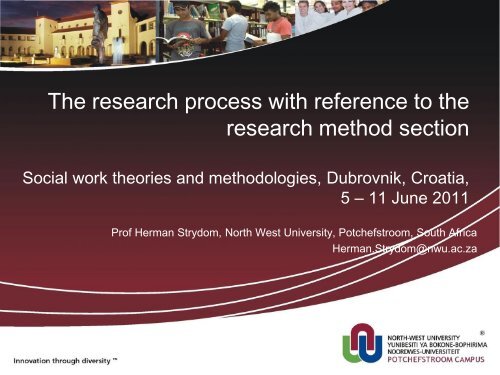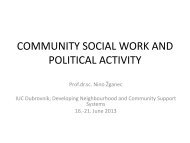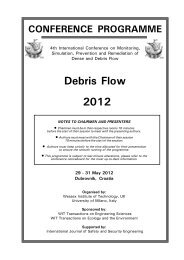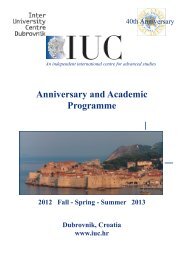The research process - IUC
The research process - IUC
The research process - IUC
You also want an ePaper? Increase the reach of your titles
YUMPU automatically turns print PDFs into web optimized ePapers that Google loves.
<strong>The</strong> <strong>research</strong> <strong>process</strong> with reference to the<br />
<strong>research</strong> method section<br />
Social work theories and methodologies, Dubrovnik, Croatia,<br />
5 – 11 June 2011<br />
Prof Herman Strydom, North West University, Potchefstroom, South Africa<br />
Herman.Strydom@nwu.ac.za
1. INTRODUCTION<br />
In this presentation the focus will be on the <strong>research</strong> method section of<br />
the total <strong>research</strong> <strong>process</strong>. In order to place <strong>research</strong> method in<br />
perspective it has to fit into the <strong>research</strong> <strong>process</strong> as such. <strong>The</strong><br />
developed schematic presentation on <strong>research</strong> method will be<br />
discussed with emphasis on <strong>research</strong> purposes and <strong>research</strong> design.<br />
<strong>The</strong> rest of the topics will be mentioned as part of the total <strong>research</strong><br />
method section of the <strong>research</strong> <strong>process</strong>. It has to be stressed that the<br />
content of this presentation is my personal opinion derived at after<br />
studying many <strong>research</strong> texts over many years. Any psycho-social<br />
<strong>research</strong>er will agree that there do not exists only one opinion on these<br />
matters and opinions are often contradictory which does not make it<br />
easier for the prospective <strong>research</strong>er. This presentation do not claim to<br />
be all encompassing and therefore no exhaustive list of for instance<br />
<strong>research</strong> designs are given and discussed.
2. RESEARCH PROCESS<br />
<strong>The</strong> <strong>research</strong> <strong>process</strong> differs much and some authors distinguish 8 or<br />
more phases, while others have 5 or 6 phases. In a study done on the<br />
viewpoints of various authors (Babbie & Mouton, 2009; Lune et al.,<br />
2010; Monette et al., 2011; Royse, 2011; Rubin & Babbie, 2010; Thyer,<br />
2010) the following 6 phases of the <strong>research</strong> <strong>process</strong> seems<br />
appropriate for the purpose of this presentation.
RESEARCH PROCESS<br />
PROBLEM STATEMENT AND RESEARCH QUESTIONS<br />
�<br />
RESEARCH METHOD<br />
�<br />
DATA COLLECTION<br />
�<br />
DATA ANALYSIS<br />
�<br />
INTERPRETATION OF DATA<br />
�<br />
WRITING THE RESEARCH REPORT
From this departure point the focus will be on the <strong>research</strong> method<br />
section of the <strong>research</strong> <strong>process</strong> specifically.
3. RESEARCH METHOD<br />
My opinion of the <strong>research</strong> method section of the <strong>research</strong> <strong>process</strong> can<br />
be delineated as following in a schematic fashion.
RESEARCH METHOD<br />
(STEP 2 OF THE PROCESS)<br />
EPISTEMOLOGICAL-ONTOLOGICAL ASSUMPTIONS<br />
�<br />
THEORETICAL MODELS<br />
�<br />
KIND OF RESEARCH<br />
�<br />
APPROACH OR PERSPECTIVE<br />
�<br />
LITERATURE STUDY<br />
�
PURPOSES<br />
�<br />
DESIGN<br />
�<br />
PARTICIPANTS/SUBJECTS<br />
�<br />
MEASURING INSTRUMENTS<br />
�<br />
PROCEDURE<br />
�<br />
ETHICAL ASPECTS<br />
�<br />
MANNER OF DATA ANALYSIS
<strong>The</strong> focus will now turn to the two highlighted sections in the schema,<br />
while the other sections will only be referred to. <strong>The</strong> next number of<br />
sources were used to delineate the <strong>research</strong> method section (Adler &<br />
Clark, 2008; Alasuutari et al., 2009; Babbie, 2010; Babbie & Mouton,<br />
2009; Cozby, 2009; Creswell, 2009; Engel & Schutt, 2010; Gomm,<br />
2009; Monette et al., 2011; Pierson & Thomas, 2010; Rubin & Babbie,<br />
2010; Trochim, 2006).
3.1 Epistemological-ontological assumptions<br />
<strong>The</strong> <strong>research</strong>er will have to mention the assumption to be used in the<br />
study whether it would for instance be Positivism, Post-positivism, the<br />
Interpretive paradigm, the Critical paradigm or Constructivism.<br />
3.2 <strong>The</strong>oretical models<br />
<strong>The</strong> <strong>research</strong>er will now have to decide on the theoretical model to be<br />
used for the study such as Systems theory, the Strengths approach, the<br />
Narrative approach, Crisis intervention, the Task centered approach or<br />
the Ecosystems approach.<br />
3.3 Kind of <strong>research</strong><br />
<strong>The</strong> kind of <strong>research</strong> must now be determined, whether it is basic,<br />
applied or integrated. Most <strong>research</strong> in Social Work, however, will be<br />
on an integrated level, seeing that Social work is by definition the<br />
integration of theory and practice.
3.4 Approach or perspective<br />
According to the previous line of thought the <strong>research</strong>er will have to<br />
decide whether the study is going to be qualitative, quantitative or<br />
mixed methods approach.<br />
3.5 Literature study<br />
<strong>The</strong> literature study in the quantitative paradigm should be done before<br />
the empirical study, while in the qualitative paradigm literature study<br />
should be done after the empirical study and is called literature control.
3.6 Purposes<br />
Most authors distinguish four purposes of <strong>research</strong>, namely<br />
exploratory, descriptive, explanatory and evaluative purposes (Engel &<br />
Schutt, 2010; Neuman, 2006; Pierson & Thomas, 2010). More than<br />
one, and even all four, purposes can be delineated for the same study,<br />
but one will normally dominate a particular study. <strong>The</strong> explorative<br />
purpose will normally focus on what questions (what are the<br />
circumstances like in the community?), while the descriptive purpose<br />
will focus on the how and who question (who is homeless? and how<br />
many are homeless?).<br />
In the explanatory purpose the why question should be answered and<br />
seeks to identify causes for and effects of behavior and are normally<br />
experimental in nature. <strong>The</strong> evaluation purpose focuses on program or<br />
practice evaluation and seeks to determine the effects of social<br />
policies, programs and interventions and thus actually encompasses<br />
the other three purposes (Rubin & Babbie, 2010).
As an example one might for instance conduct qualitative open-ended<br />
exploratory interviews with some community members as a first step<br />
towards evaluating what services the community need. Subsequently a<br />
quantitative descriptive survey might be done to evaluate the problems<br />
community members have and the services they need. <strong>The</strong> questions<br />
for this survey can partly be based on the open-ended answers of the<br />
first section of this particular study. An explanatory analysis might now<br />
be done to evaluate for instance why some groups from this community<br />
are more likely to utilize certain services. If you then would compile a<br />
program to address the community’s needs, with a before and after<br />
measurement included, one can say that an evaluation purpose had<br />
been achieved.
3.7 Design<br />
Babbie and Mouton (2009: 72) define design as the planning of<br />
scientific inquiry, meaning to specify as clearly as possible what you<br />
want to find out and to determine the best way to do so. Creswell and<br />
Plano-Clark (2007: 4) add that the <strong>research</strong> design is the plan of action<br />
that links the philosophical assumptions to specific methods. For the<br />
purpose of this presentation the term <strong>research</strong> design will refer to the<br />
specific design such as experimental or survey and the specific subdesign<br />
(Creswell, 2009; Creswell & Plano-Clark, 2007; Pierson &<br />
Thomas, 2010; Trochim, 2006).
• Experimental design can be distinguished and specifically the<br />
classic experiment, the after test control group only and the<br />
Solomon four group as sub-designs. <strong>The</strong> quasi experiment can also<br />
be grouped in this category (Trochim, 2006).<br />
• Single systems can be seen in the category of experimental<br />
<strong>research</strong>, except that single systems use one individual or group<br />
and do not have a control group (Strydom, 2011a).<br />
• Survey design can be seen as a quantitative design and can have a<br />
number of sub-designs, such as the postal questionnaire, the<br />
structured interview, the telephonic interview and the group<br />
interview.<br />
• In-depth interviewing can be regarded as a qualitative design and<br />
can be of a semi-structured or unstructured format.
• Focus groups are also of a qualitative nature and can be conducted<br />
in a semi-structured or unstructured form (Greeff, 2011).<br />
• Document study and secondary analysis are often seen as similar.<br />
However, Strydom & Delport (2011) make the following distinction.<br />
Document study involves the study of existing documents, such as<br />
letters to friends or family, diaries, confessions, autobiographies,<br />
minutes of meetings and the mass media, while secondary analysis<br />
on the other hand refers to the reworking of already analyzed data in<br />
which the current <strong>research</strong>er had no direct control over or<br />
involvement in.<br />
• Participant observation can be done in the form of the total observer,<br />
the observer as participant, the participant as observer and the total<br />
participant on a continuum of involvement with participants<br />
(Strydom, 2011b).
• Program evaluation focuses on the practical situation, the evaluation<br />
of a program and to provide information that can be used to improve<br />
such programs (Royse et al., 2010).<br />
3.8 Participants/subjects<br />
In this section an explanation takes place on the number of subjects (in<br />
the case of quantitative <strong>research</strong>) or an estimation of the number of<br />
participants (in the case of qualitative <strong>research</strong>). In qualitative <strong>research</strong><br />
it is not always possible to have a specific number of participants and<br />
will data-collection normally continues until proper data-saturation has<br />
been reached.
3.9 Measuring instruments<br />
A discussion will take place on the measuring instrument/s to be used<br />
in the study, whether it is standardized measuring instruments,<br />
attitudinal scales, observation of behavior, personal scales and rating<br />
scales, diaries or unobtrusive measures.<br />
3.10 Procedure<br />
In this part of the <strong>research</strong> method the procedure or steps that will be<br />
followed during the <strong>research</strong> study will be discussed. For instance the<br />
<strong>research</strong>er can say that ethical clearance will be gained, then<br />
participants will be recruited and then the actual design implemented.
3.11 Ethical issues<br />
All applicable ethical issues such as privacy, confidentiality, debriefing<br />
and informed consent will be discussed with an application on the<br />
specific <strong>research</strong> scenario.<br />
3.12 Manner of data analysis<br />
In the case of quantitative <strong>research</strong> statistical analysis of data will be<br />
done, while in the case of qualitative <strong>research</strong>, data analysis will be<br />
done according to text analysis and analysis of narratives.
4. CONCLUSION<br />
<strong>The</strong> focus of this presentation was on the <strong>research</strong> method section of<br />
the <strong>research</strong> <strong>process</strong>, and especially the purposes of <strong>research</strong> and the<br />
<strong>research</strong> design. Four purposes of <strong>research</strong> were delineated, namely<br />
exploratory, descriptive, explanatory and evaluative purpose. As far as<br />
<strong>research</strong> designs are concerned, the following were discussed, namely<br />
experimental, single systems, survey, in-depth interviewing, focus<br />
groups, document study and secondary analysis, and participant<br />
observation.
Bibliography<br />
Adler, E.S. & Clark, R. 2008. How it’s done: an invitation to social<br />
<strong>research</strong>. New York: Thomson Wadsworth.<br />
Alasuutari, P., Bickman, L. & Brannen, J. 2009. <strong>The</strong> SAGE Handbook<br />
of social <strong>research</strong> methods. Los Angeles: SAGE Publications.<br />
Babbie, E. 2010. <strong>The</strong> practice of social <strong>research</strong>. London: Wadsworth<br />
Cengage Learning.<br />
Babbie, E. & Mouton, J. 2009. <strong>The</strong> practice of social <strong>research</strong>. Cape<br />
Town: Oxford University Press.<br />
Cozby, P.C. 2009. Methods in behavioral <strong>research</strong>. Boston: McGraw<br />
Hill Higher Education.<br />
Creswell, J.W. 2009. Research design: qualitative, quantitative, and<br />
mixed methods approaches. Los Angeles: SAGE Publications.<br />
Creswell, J.W. & Plano Clark, V.L. 2007. Designing and conducting<br />
mixed methods <strong>research</strong>. Thousand Oaks: SAGE Publications.
Engel, R.J. & Schutt, R.K. 2010. Fundamentals of social work <strong>research</strong>.<br />
London: SAGE Publications.<br />
Gomm, R. 2009. Key concepts in social <strong>research</strong> methods. London:<br />
Palgrave Macmillan.<br />
Greeff, M. 2011. Information collection: interviewing. (In De Vos et al.<br />
Research at grass roots: for the social sciences and human service<br />
professions. p. 341-375.)<br />
Lune, H., Pumar, E.S. & Koppel, R. 2010. Perspectives in social<br />
<strong>research</strong> methods and analysis: a reader for sociology. London: SAGE<br />
Publications.<br />
Monette, D.R., Sullivan, T.J. & DeJong, C.R. 2011. Applied social<br />
<strong>research</strong>: a tool for the human services. London: Brooks/Cole<br />
Cengage Learning.<br />
Neuman, W.L. 2006. Social <strong>research</strong> methods: qualitative and<br />
quantitative approaches. Boston: Pearson Allyn and Bacon.
Pierson, J. & Thomas, M. 2010. Dictionary of social work: the definitive<br />
A to Z of social work and social care. London: McGraw Hill Open<br />
University Press.<br />
Royse, D., Thyer, B.A. & Padgett, D.K. 2010. An introduction to<br />
program evaluation. New York: Wadsworth Cengage Learning.<br />
Rubin, A. & Babbie, E.R. 2010. Essential <strong>research</strong> methods for social<br />
work. New York: Brooks/Cole Cengage Learning.<br />
Strydom, H. 2011a. Single-system design. (In De Vos, A.S.et al.<br />
Research at grass roots: for the social sciences and human service<br />
professions. p. 159-170.)<br />
Strydom, H. 2011b. Information collection: participant observation. (In<br />
De Vos, A.S. et al. Research at grass roots: for the social sciences and<br />
human service professions. p. 328-340.)
Strydom, H. & Delport, C.S.L. 2011. Sampling and pilot study in<br />
qualitative <strong>research</strong>. (In De Vos, A.S. et al. Research at grass roots: for<br />
the social sciences and human service professions. p. 376-389.)<br />
Thyer, B. 2010. <strong>The</strong> handbook of social work <strong>research</strong> methods.<br />
London: SAGE Publications.<br />
Trochim, W.M.K. 2006. Design.<br />
http://www.social<strong>research</strong>methods.net/kb/design.php Date of access:<br />
22December 2010.
















